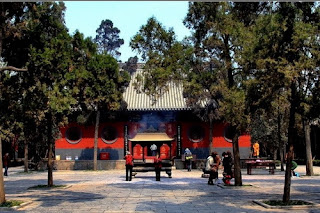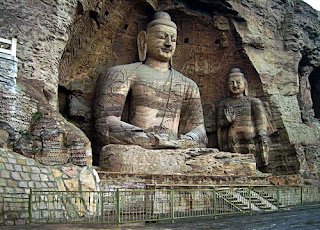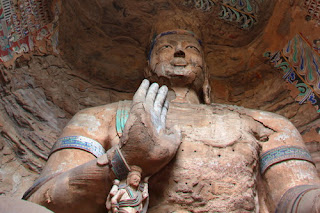White Horse Temple
The White Horse Temple enjoys the reputation of the No.1 Ancient Temple of China. It lies on the south of Mangshan Mountain, and faces the Luohe River in the south. The construction of the temple started in the 11th year (68) during the Yongping reign of Emperor Mingdi in the Eastern Han Dynasty (25-220). The White Horse Temple has a history of over 1900 years. It is the first temple built since Buddhism spread to China in the Han Dynasty (206BC-220AD).
 |
| The Whole View if White Horse Temple |
According to historical records, Emperor Mingdi of the Eastern Han Dynasty dreamed of a golden man flying above the courtyard. After he woke up, the emperor sent Cai Yin and Qin Jing as envoys to western regions to invite Buddha and learn Buddhism. The two envoys underwent much hardship and met two eminent Indian dignitaries She Moteng and Zhu Falan on the way.
Cai Yin and Qin Jing came back to Luoyang City with the two monks, and a white horse carrying the sutras. Emperor Mingdi ordered the construction of the temple to the north of the imperial road outside the Xiyong Gate of Luoyang City. The White Horse Temple, built after the style of Indian temples, was the place for She Moteng and Zhu Falan to translate Buddhist sutras and write sermons. In order to memorize the white horse for its carrying back of the sutras, the temple was named the White Horse Temple.
 |
| White Horse Temple |
The White Horse Temple has undergone many repairs and renovations in all previous dynasties. The present appearance is much different from its original one. What we see today was restored during the Ming Dynasty (1368-1644) and the Qing Dynasty (1644-1911), with an area of 34,000 square meters.
Facing south, the main buildings of the temple stand on or along the central axis, including the Temple Gate, the Heavenly King Hall, the Great Buddha Hall, the Main Hall, the Jieyin Hall, and the Pilu Pavilion, etc. Beside those main buildings are the Reception Chamber, the Cloud-water Chamber, the Ancestors Chamber, the Guests Chamber, the Buddhist Chamber, and the Abbot Courtyard and so on. The huge White Horse Temple has over 100 rooms.
Places to See
Hall of Heavenly Kings
This hall was originally built in the Yuan Dynasty. In the middle of the hall sits a laughing Buddha - Maitreya. It is said that the Buddha was once incarnated as a beggar monk with a purse, which actually contained all the treasures of the world. The shrine is made of wood with over 50 vivid dragons carved into it and is truly a remarkable example of Qing Dynasty (1644-1911) culture. On either side of Maitreya stand the four majestic 'Celestial Kings'. Each holds a different weapon and all four are clay sculptures moulded during the Qing Dynasty.
 |
| Hall of Heavenly Kings |
Hall of the Great Buddha
This hall boasts the most spectacular architecture in the whole temple. The roof is covered with exquisite pantiles; the upturned eaves and the bracket system reflect the architectural style of the Ming Dynasty (1368-1644). A statue of the Buddhist patriarch Sakyamuni stands in the middle of the hall for people to make offerings to. He is flanked by two of his disciples - Kasyapa and Ananda. The one with sutra in his hands is the Bodhisattva of Wisdom - Manjusri. The other is the Bodhisattva of Universal Benevolence - Samantabhadra. All of these statues provide vivid portraits with smooth lines and demonstrate a high level of craftsmanship of the Ming Dynasty.
Hall of Guidance
This hall is where the Amitabha Buddha is worshipped and is the smallest in the temple. This Buddha is in charge of the Western Paradise. On his right and left are the Bodhisattva of
 |
| Hall of the Great Buddha |
Hall of Mahavira
This is the most magnificently decorated hall in the temple. The roof is carved with colorful lotus patterns and the walls are hung with thousands of the wooden statues of Buddhist figures. In the centre of the hall stands a two-storey Buddhist shrine exquisitely carved with birds in flight and giant winding dragons which lend the shrine its awesome appearance. The three saints Sakyamuni, Amitabha and the Buddha of Medicine look jovial with the eighteen arhats standing around and all are made from silk and hemp. Each one weighs only three to five kilograms (about seven to eleven pounds). The colors on these statues are still as fresh today as when they were first produced during the Yuan Dynasty. They are priceless treasures of the nation.
The Cool and Clear Terrace
 |
| The Exterior of Hall of Mahavira |
This is a high brick terrace built in the yard at the rear of the temple where the sutras and Buddhist figures, brought back by the white horse, were once stored. It is also the place where the two Indian monks translated the sutras during the Eastern Han Dynasty. The terrace was the first place at which Buddhist sutras were translated in China and for this reason, it is one of the most famous locations in the temple.
Outside the temple, there is a tiered brick pagoda named Qiyun Pagoda, which is actually the oldest of China's ancient pagodas. It is the earliest example of ancient architecture in Luoyang and also one of the most precious Jin Dynasty (1115-1234) structures in the Central Plains of China. Standing south of the pagoda and clapping your hands, you will discover that the echoes you hear sound quite similar to the noise of frogs croaking. This perplexing phenomenon attracts many curious tourists every day.
As the first Buddhist temple in China, the White Horse Temple plays a significant role in the history of Chinese Buddhism and China's international cultural exchanges. After the founding of the People's Republic of China, the People's Government paid much attention to the temple and thoroughly restored it several times from 1952 to 1973. It has become an attraction to domestic and foreign tourists.



